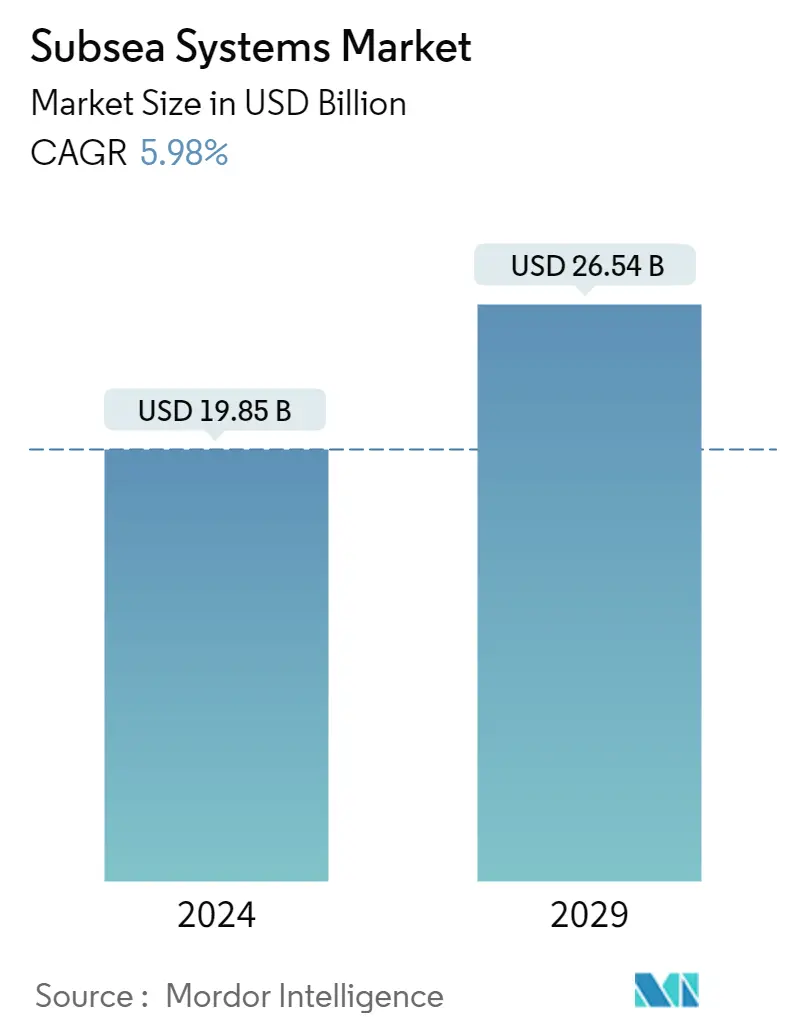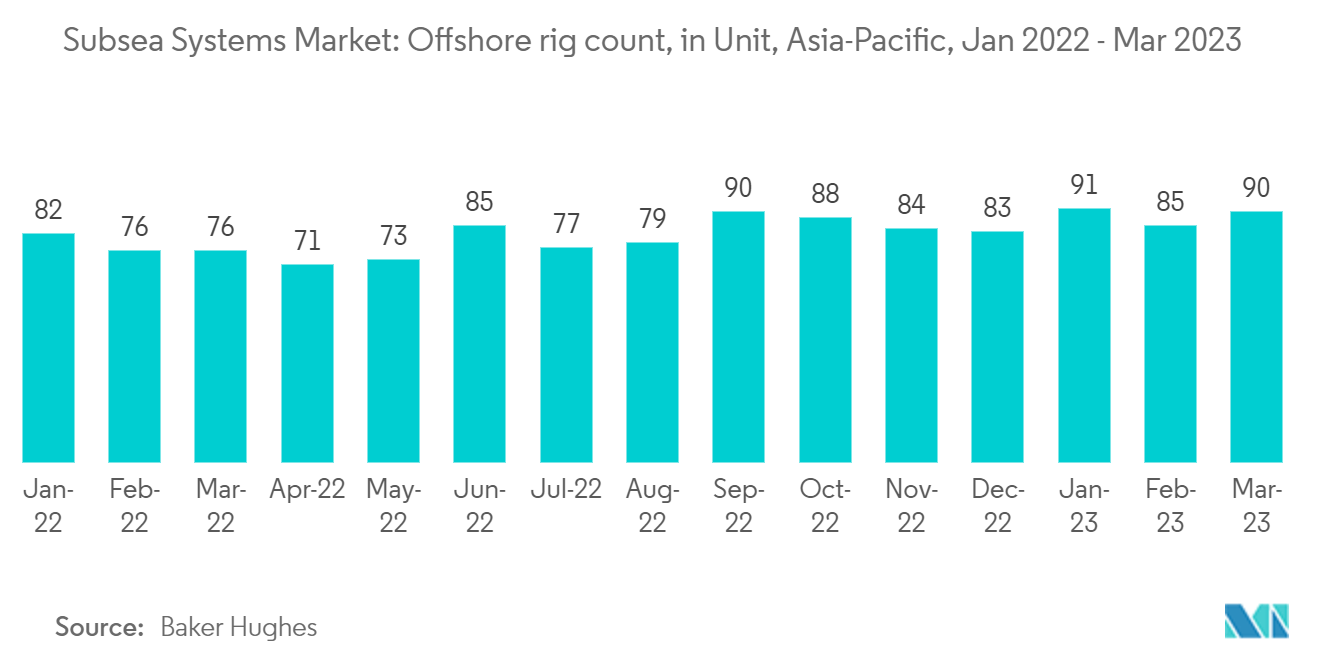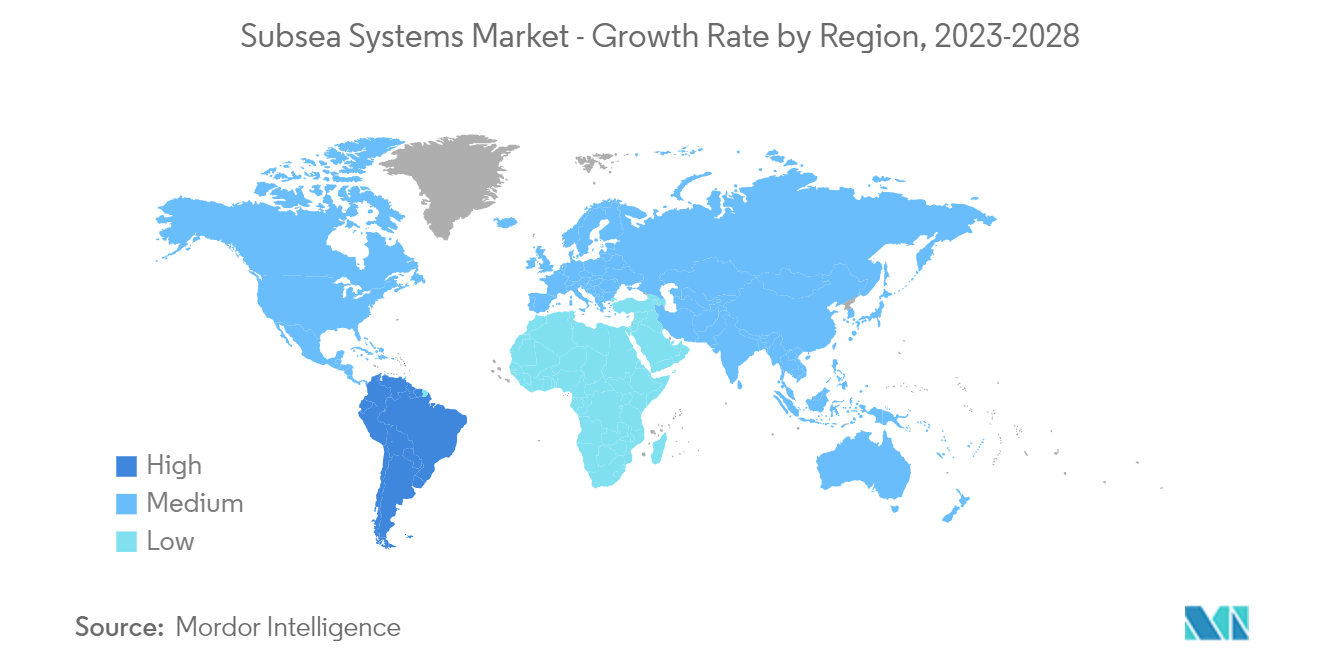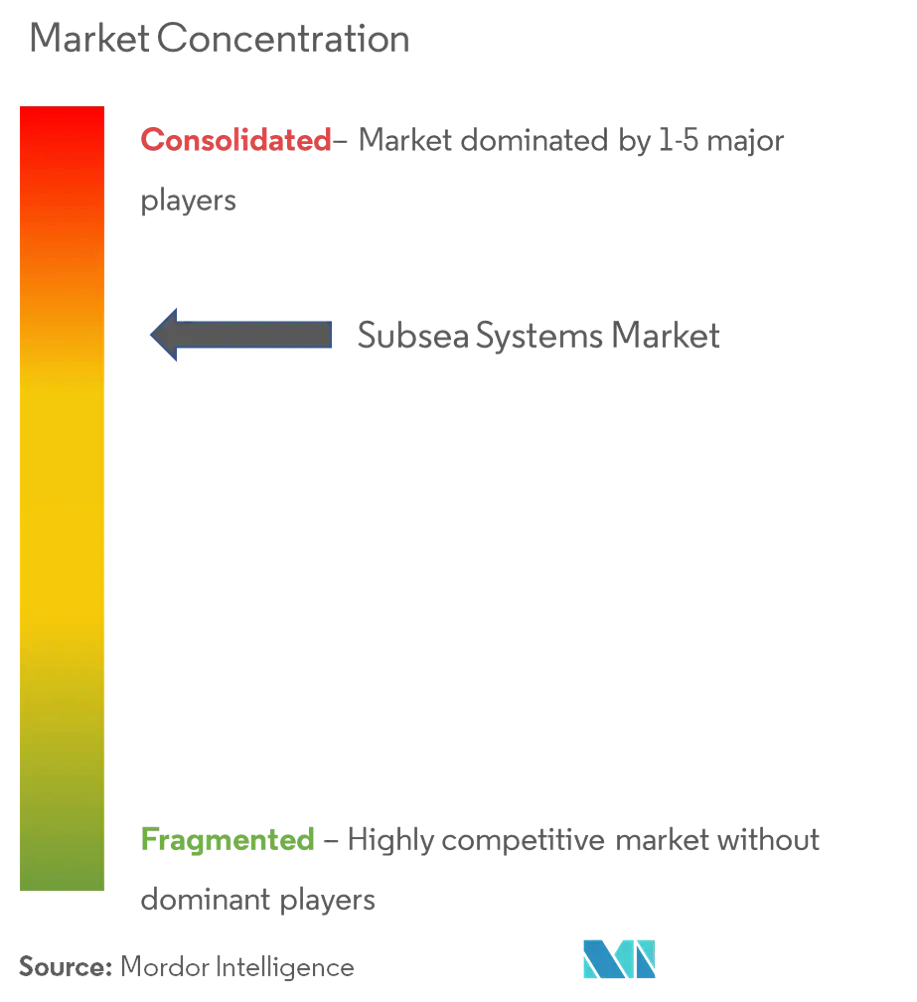Subsea Systems Market Size

| Study Period | 2020 - 2029 |
| Market Size (2024) | USD 19.85 Billion |
| Market Size (2029) | USD 26.54 Billion |
| CAGR (2024 - 2029) | 5.98 % |
| Fastest Growing Market | South America |
| Largest Market | North America |
Major Players
*Disclaimer: Major Players sorted in no particular order |
Subsea Systems Market Analysis
The Subsea Systems Market size is estimated at USD 19.85 billion in 2024, and is expected to reach USD 26.54 billion by 2029, growing at a CAGR of 5.98% during the forecast period (2024-2029).
The market was negatively impacted by the outbreak of COVID-19, the crash in the price of crude oil, and delays in ongoing projects. Currently, the market has rebounded to pre-pandemic levels.
- Factors such as the increase in oil prices after the downturn period and growing investments in the offshore oil and gas sector are expected to be major drivers for the offshore oil and gas equipment and services market and, in turn, the subsea systems market during the forecast period. Moreover, the improving viability of offshore projects and rising activity in deepwater and ultra-deepwater reserves are likely to boost the market.
- However, the high installation cost of subsea equipment and risks associated with offshore drilling and production are expected to hinder the growth of the subsea systems market.
- Increasing deepwater activities in countries like Brazil, Egypt, the United States, Iran, and Qatar is likely to create several opportunities for the players in the subsea systems market.
- South America is expected to be the fastest-growing market for subsea systems. The majority of the demand comes from Brazil due to its recent activities in deepwater and ultra-deepwater and several upcoming projects.
Subsea Systems Market Trends
Subsea Production Segment to Dominate the Market
- With the rising number of maturing onshore oilfields in recent years, there has been growth in offshore exploration and production (E&P) activities. For instance, in the Permian Basin, the most critical basin in terms of crude oil production, the production from old wells has started to decline, and there needs to be more scope for discovery in these areas.
- According to Baker Hughes, as of March 2023, Asia-Pacific has 90 active offshore rigs. With the increasing exploration, rig counts are expected to grow significantly as more offshore discoveries are made, which, in turn, will boost the demand for the subsea production system.
- For instance, in February 2022, EniSpA announced its first exploration well in Abu Dhabi. The company also revealed that it had recorded positive results from its first exploration well, XF-002, currently under drilling in offshore Block 2 Abu Dhabi (UAE) at 115 feet of water depth.
- With the increasing deepwater and ultra-deepwater activities in the South American, North American, and European regions, the deepwater fields' production is expected to reach 7.6 million barrels per day by 2025 and 9 million barrels per day by 2040. Hence, the demand for subsea production systems is expected to increase and further drive the market.
- Therefore, the oil and gas industry is shifting toward deeper regions to search for oil and gas to meet the increasing demand. Hence, the subsea production systems share is expected to be the largest among subsea system segments and drive the market.

South America to Dominate the Market Growth
- As the energy demand increases rapidly, various countries, major companies, and investors are shifting their interest toward deep water, as it holds the potential for a guaranteed supply of oil and gas for a few decades. However, this requires employing technology to produce oil and gas reserves buried thousands of meters deep in the ocean floor. This has increased the need for subsea systems to improve recovery and reduce overall costs.
- In 2021, Brazil produced an average of 2.99 million barrels per day of crude oil and condensate, representing an average increase of more than 150,000 barrels per day compared with 2019. According to the EIA, Brazil is a global leader in developing deep and ultra-deepwater projects. In recent years, changes in government policies, such as liberalization in the oil and gas sector, have attracted foreign investment.
- Many foreign players worldwide are scouting Brazil for a potential investment market in offshore hydrocarbon activities during the next decade. For instance, in October 2022, ONGC Videsh Ltd (OVL) planned to invest USD 1 billion in a Brazilian offshore hydrocarbon block. Such projects are likely to impact the subsea systems market during the forecast period positively.
- Similarly, Argentina's state-backed energy company YPF expects its first offshore project to produce up to 200,000 barrels per day, which would drive the demand for subsea systems in the country as production resumes.
- Hence, the upcoming projects in deep-water and ultra-deep-water are likely to drive the growth of the subsea systems market during the forecast period in the South American region.

Subsea Systems Industry Overview
The subsea systems market is moderately consolidated. Some of the key players in the market (in no particular order) include Subsea 7 SA, TechnipFMC PLC, Akastor ASA, National-Oilwell Varco Inc., and Baker Hughes Co., among others.
Subsea Systems Market Leaders
-
Subsea 7 SA
-
TechnipFMC PLC
-
Akastor ASA
-
National-Oilwell Varco Inc
-
Baker Hughes Co.
*Disclaimer: Major Players sorted in no particular order

Subsea Systems Market News
- February 2023: Equinor made a new commercial oil and gas discovery in the North Sea off Norway using a Transocean-owned rig. The discovery was made after the conclusion of drilling a wildcat well (31/1-3 S) and an appraisal well (31/1-3 A) in production license 923.
- February 2022: Norwegian Innova and the US Teledyne Energy System partnered to demonstrate the use of hydrogen for local power in subsea control systems. The companies took the validation test at the Norwegian Center for Offshore Education, Tau Autonomy Center in Tau, Norway, which included a well intervention simulation in which the Subsea Supercharger powered a subsea hydraulic pumping unit (sHPU) developed by Innova.
- March 2022: British oil & gas company BP PLC won two offshore exploration blocks, Agung l, and Agung ll, in Indonesia, as part of the government's second round of the 2021 Oil & Gas Working Area (WK) Bid Round.
Subsea Systems Market Report - Table of Contents
1. INTRODUCTION
- 1.1 Scope of the Study
- 1.2 Market Definition
- 1.3 Study Assumptions
2. RESEARCH METHODOLOGY
3. EXECUTIVE SUMMARY
4. MARKET OVERVIEW
- 4.1 Introduction
- 4.2 Market Size and Demand Forecast in USD billion, till 2028
- 4.3 Historic and Demand Forecast of Offshore CAPEX in billions, by Water Depth, 2019-2028
- 4.4 Historic and Demand Forecast of Offshore CAPEX in billions, by Region, 2019-2028
- 4.5 Recent Trends and Developments
- 4.6 Government Policies and Regulations
-
4.7 Market Dynamics
- 4.7.1 Drivers
- 4.7.1.1 Improved Viability Of Offshore Oil And Gas Projects
- 4.7.1.2 Rising Deep Water Oil & Gas Exploration And Production Activities In The Americas, Asia-pacific, And Middle-east & Africa Region
- 4.7.2 Restraints
- 4.7.2.1 Ban On Offshore Exploration And Production Activities In Multiple Regions
- 4.8 Supply Chain Analysis
-
4.9 Porter's Five Forces Analysis
- 4.9.1 Bargaining Power of Suppliers
- 4.9.2 Bargaining Power of Consumers
- 4.9.3 Threat of New Entrants
- 4.9.4 Threat of Substitute Products and Services
- 4.9.5 Intensity of Competitive Rivalry
5. MARKET SEGMENTATION
-
5.1 Type
- 5.1.1 Subsea Production Systems
- 5.1.2 Subsea Processing Systems
-
5.2 Component
- 5.2.1 Subsea Umbical Riser and Flowlines (SURF)
- 5.2.2 Trees
- 5.2.3 Wellhead
- 5.2.4 Manifolds
- 5.2.5 Other Components
-
5.3 Geography
- 5.3.1 North America
- 5.3.1.1 Canada
- 5.3.1.2 Mexico
- 5.3.1.3 United States of America
- 5.3.1.4 Rest of the North America
- 5.3.2 Europe
- 5.3.2.1 Norway
- 5.3.2.2 United Kingdom
- 5.3.2.3 France
- 5.3.2.4 Italy
- 5.3.2.5
- 5.3.3 Asia-Pacific
- 5.3.3.1 China
- 5.3.3.2 India
- 5.3.3.3 Japan
- 5.3.3.4 Rest of the Asia-Pacific
- 5.3.4 South America
- 5.3.4.1 Brazil
- 5.3.4.2 Argentina
- 5.3.4.3 Rest of the South America
- 5.3.5 Middle East and Africa
- 5.3.5.1 United Arab Emirates
- 5.3.5.2 Saudi Arabia
- 5.3.5.3 Iran
- 5.3.5.4 Iraq
- 5.3.5.5 Rest of the Middle East and Africa
6. COMPETITIVE LANDSCAPE
- 6.1 Mergers and Acquisitions, Joint Ventures, Collaborations, and Agreements
- 6.2 Strategies Adopted by Leading Players
-
6.3 Company Profiles
- 6.3.1 Akastor ASA
- 6.3.2 Subsea 7 SA
- 6.3.3 TechnipFMC PLC
- 6.3.4 National-Oilwell Varco Inc.
- 6.3.5 Baker Hughes Co.
- 6.3.6 Schlumberger Ltd
- 6.3.7 Halliburton Co.
- 6.3.8 Oceaneering International
- 6.3.9 Kerui Group Co. Ltd
- 6.3.10 Dril-Quip Inc.
- *List Not Exhaustive
7. MARKET OPPORTUNITIES AND FUTURE TRENDS
- 7.1 Technology Advancements In Subsea Production And Processing Systems
Subsea Systems Industry Segmentation
Subsea systems are fully submerged ocean equipment, operations, or applications, especially when some distance offshore, in deep ocean waters, or on the seabed. The term is frequently used in connection with oceanography, marine or ocean engineering, ocean exploration, remotely operated vehicles (ROVs), autonomous underwater vehicles (AUVs), submarine communications or power cables, seafloor mineral mining, oil and gas, and offshore wind power.
The subsea systems market is segmented by type, component, and region. The market is segmented by type into subsea production systems and subsea processing systems. The market is segmented by components into subsea umbilical risers and flowlines (SURF), trees, wellheads, manifolds, and other components. The report also covers the market size and forecasts for the subsea systems market across major regions. Market sizing and forecasts have been done for each segment based on revenue (USD billion).
| Type | Subsea Production Systems | |
| Subsea Processing Systems | ||
| Component | Subsea Umbical Riser and Flowlines (SURF) | |
| Trees | ||
| Wellhead | ||
| Manifolds | ||
| Other Components | ||
| Geography | North America | Canada |
| Mexico | ||
| United States of America | ||
| Rest of the North America | ||
| Geography | Europe | Norway |
| United Kingdom | ||
| France | ||
| Italy | ||
| Geography | Asia-Pacific | China |
| India | ||
| Japan | ||
| Rest of the Asia-Pacific | ||
| Geography | South America | Brazil |
| Argentina | ||
| Rest of the South America | ||
| Geography | Middle East and Africa | United Arab Emirates |
| Saudi Arabia | ||
| Iran | ||
| Iraq | ||
| Rest of the Middle East and Africa |
Subsea Systems Market Research FAQs
How big is the Subsea Systems Market?
The Subsea Systems Market size is expected to reach USD 19.85 billion in 2024 and grow at a CAGR of 5.98% to reach USD 26.54 billion by 2029.
What is the current Subsea Systems Market size?
In 2024, the Subsea Systems Market size is expected to reach USD 19.85 billion.
Who are the key players in Subsea Systems Market?
Subsea 7 SA, TechnipFMC PLC, Akastor ASA, National-Oilwell Varco Inc and Baker Hughes Co. are the major companies operating in the Subsea Systems Market.
Which is the fastest growing region in Subsea Systems Market?
South America is estimated to grow at the highest CAGR over the forecast period (2024-2029).
Which region has the biggest share in Subsea Systems Market?
In 2024, the North America accounts for the largest market share in Subsea Systems Market.
What years does this Subsea Systems Market cover, and what was the market size in 2023?
In 2023, the Subsea Systems Market size was estimated at USD 18.73 billion. The report covers the Subsea Systems Market historical market size for years: 2020, 2021, 2022 and 2023. The report also forecasts the Subsea Systems Market size for years: 2024, 2025, 2026, 2027, 2028 and 2029.
What are the technological advancements driving innovation in the Subsea Systems Market?
Technological advancements such as subsea boosting, separation, injection, and compression systems are driving innovation in the Subsea Systems Market. These technologies enable enhanced oil recovery and improved fluid handling.
Subsea Systems Industry Report
The global subsea systems market is poised for significant market growth, driven by increasing deepwater production and exploration activities, alongside investments from emerging economies in offshore exploration. The industry overview indicates that the market is segmented by type into subsea production and subsea processing systems, with subsea production expected to dominate due to the rising number of maturing onshore oilfields and the subsequent shift towards offshore exploration. Key components of subsea production systems include Subsea Umbilicals, Risers, Flowlines (SURF), subsea trees, control systems, and subsea manifolds.
Subsea processing technologies such as boosting, separation, injection, and compression are essential for enhancing hydrocarbon recovery at the seabed. The subsea industry is further supported by advancements in subsea technology and the increasing viability of offshore projects. The market overview highlights an ecosystem comprising original equipment manufacturers, service providers, and oilfield operators, with a focus on improving recovery and reducing costs in offshore oil and gas production.
The industry analysis includes a market forecast outlook and historical overview. The market segmentation covers different geographical regions including North America, Europe, Asia-Pacific, South America, and the Middle East and Africa. The industry research shows that the market size and forecasts are provided in terms of revenue for all the segments. The market trends indicate a growth rate influenced by market leaders and market data from various research companies.
Statistics for the subsea systems market share, size, and revenue growth rate are provided by Mordor Intelligence™ Industry Reports. The industry outlook and market predictions suggest a positive trajectory for the subsea systems market. This market report and industry information can be accessed in a report example or as a report pdf download. The market review and industry statistics underline the importance of subsea systems in the offshore oil and gas industry.



